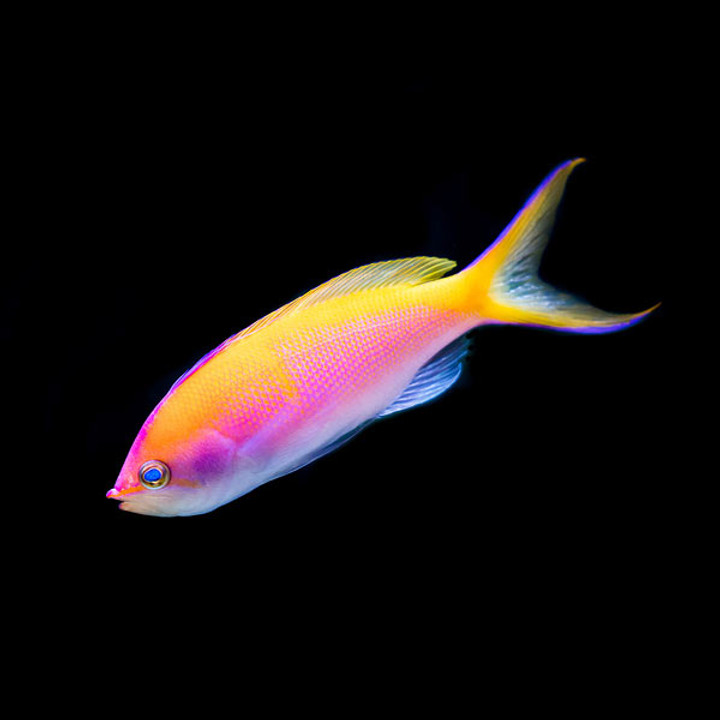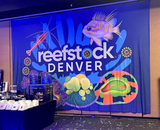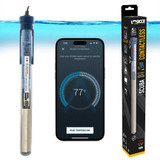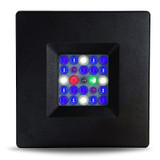Anthias...Really that Hard to Keep?
Easily some of the most colorful saltwater fish available to aquarists are collectively known as Anthias. Sherbet orange, electric yellow, bright red, pink squares and light purple polka dots are all common colors found on these fish.
Despite their popularity and availability, they do have a mixed reputation in the hobby. Some find them difficult to please while others keep dozens of them in bigger systems. They are generally thought of as a metabolically hyperactive fish that require a lot of food input during the day and that’s not far from the truth. In the wild, you will find them in massive shoals numbering in the thousands, hanging just above the reef structure, eating small crustaceans and raining down poop for all the inverts to enjoy.
There are some species which are more solitary but that is the exception and not the norm. Borbonus and Sunburst Anthias come to mind here. They are more likely to lurk in the cracks and crevices of the reef for the most part rather than pacing back in forth from one side to the other like Bartlett’s or Squampinnis.
Successfully keeping groups of Anthias requires a system and methods not that uncommon from any other type of saltwater fish. Great filtration, consistent and acceptable water quality parameters, and often lots of food throughout the day. That’s likely one slight difference from many other fish that we keep; frequent feedings. Many other fish we keep do fine with 1-2 feedings per day. Anthias are going to do better with access to food more often than that. A great way to achieve this is by using an auto feeder and floating feed ring. For those of you utilizing a Neptune Apex, you could send the system into a feed mode where the main pump shuts off so the food doesn’t simply run down the drains. That serves no purpose other than to degrade water quality. For those without an Apex, just having an auto feeder dump into a floating feeding ring (like the magnetically tethered unit offered by Two Little Fishies) strategically placed to catch and contain the small, floating pellets. A great food that comes to mind here is Reef Nutrition’s TDO or New Life Spectrum pellets. Not all anthias will take readily to pellets though. Frozen mysis shrimp, fish eggs, calanus, brine shrimp, there are many great frozen food nowadays.
Here’s the rub. With a small shoal of Anthias eating pellets dosed into the tank maybe 3-6 times a day or more, we need to keep a couple things in mind. Keep the feedings small in volume but frequent, have great and comprehensive filtration, test regularly in order to quantify what affects these nutrient inputs are having on your water quality, and have other clean-up type creatures who can help mop up any uneaten food. Nassarius snails, margarita snails, Trochus, Astrea, etc., fighting conchs and olive snails, serpent starfish, tiger tail and edulis cucumbers, a few small hermit crabs, maybe an urchin or two, peppermint, cleaner, coral banded and blood red shrimp. These are all great things to have mopping up uneaten food like little vultures and hyaena. It’s better in the belly of a creature than rotting away in the water. It’s a careful balance of food input volume to satisfied guts and might take a bit of careful observation and frequent adjusting. If you run a tight ship in regards to equipment upkeep and regular maintenance, keeping Anthias happy shouldn’t be a big deal.
If any of this seems daunting or intimidating, I would suggest to hold off on attempting to keep Anthias until you feel more confident. This is why I would say keeping them isn’t difficult, but it also isn’t simple either.
In my experience, Anthias also do better with longer tanks; something they can stretch their fins out in. Perhaps a minimum of 4’ would be sufficient. Vigorous water movement with random flow patterns is also helpful.
Anthias are often kept in harems, which means one male to several females. Many times males and females are distinctive colors so they are easy to tell apart.
If you have a fair amount of experience and you know your system can take it, give it a shot. Not many other saltwater fish bring that much color and movement to a system like Anthias do.
Explore Popular Articles
-
ReefStock Denver is This Weekend!
Feb 27, 2024The time is finally here. Reef Builders ReefStock Show is coming to the Crowne Plaza Hotel in Denve
-
Sicce's New Scuba Heater!
Oct 23, 20235 Year Warranty, High Quality Italian Made, A Heater for the FUTURE! Innovative heater range eq
-
Current USA R24 LOOP LED
Oct 23, 2023Compact lighting with SPS coral growing power. For those who love the Orbit® Marine, the Orbit® R




